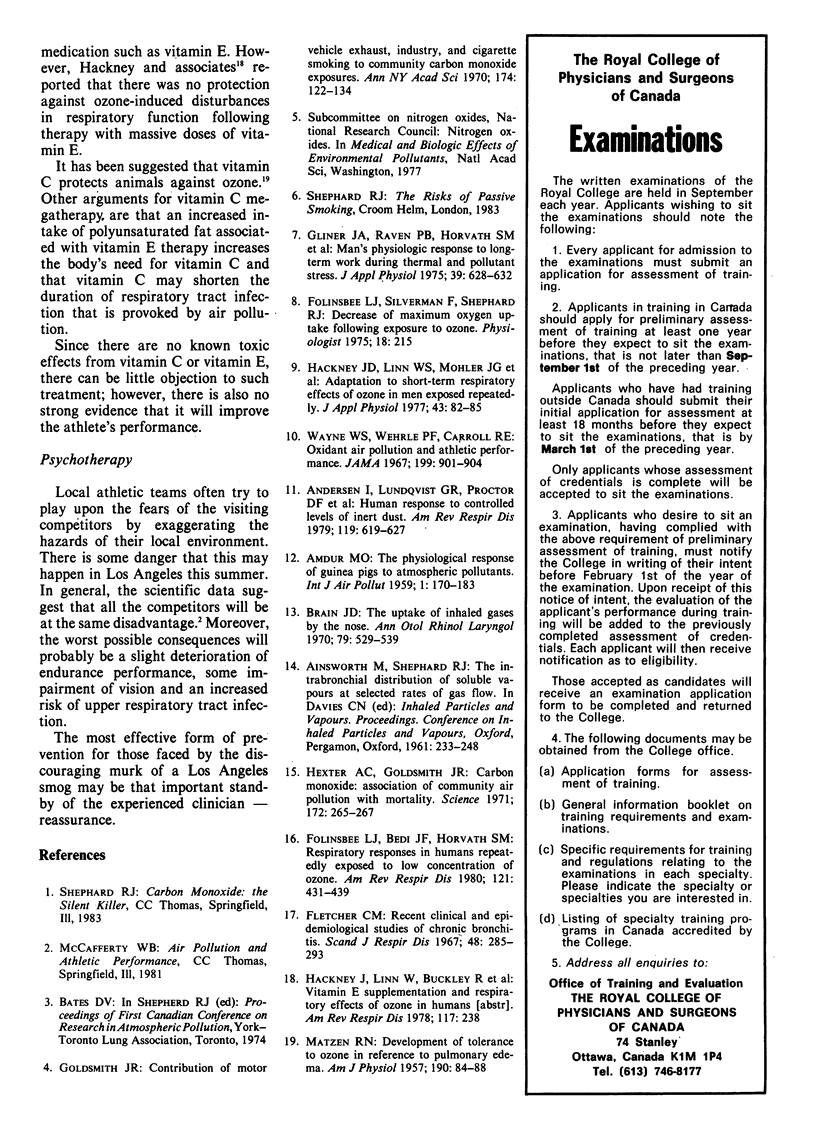Abstract
Air pollution may affect athletic performance. In Los Angeles, contaminants include carbon monoxide, ozone, peroxyacetylnitrate (PAN) and nitrogen oxides, whereas in older European cities, such as Sarajevo, "reducing smog" of sulfur dioxide is the main hazard. The carbon monoxide and ozone levels expected in Los Angeles this summer could affect the athletes' performance in endurance events at the Olympic Games. Carbon monoxide may also impair psychomotor abilities, and PAN causes visual disturbances. The only likely physiologic consequence from reducing smog is an increase in the workload of the respiratory system and thus a decrease in endurance performance. While carbon monoxide has been blamed for myocardial infarctions, nitrogen oxides for pulmonary edema and sulfur dioxide for deaths due to respiratory failure, the only illnesses that are likely to be more frequent than usual among young athletes exposed to high levels of these pollutants are upper respiratory tract infections. Therapeutic tactics include the avoidance of pollution, the administration of oxygen, vitamin C and vitamin E, and general reassurance.
Full text
PDF




Selected References
These references are in PubMed. This may not be the complete list of references from this article.
- AMDUR M. O. The physiological response of guinea pigs to atmospheric pollutants. Int J Air Pollut. 1959 Jan;1(3):170–183. [PubMed] [Google Scholar]
- Andersen I., Lundqvist G. R., Proctor D. F., Swift D. L. Human response to controlled levels of inert dust. Am Rev Respir Dis. 1979 Apr;119(4):619–627. doi: 10.1164/arrd.1979.119.4.619. [DOI] [PubMed] [Google Scholar]
- Brain J. D. The uptake of inhaled gases by the nose. Ann Otol Rhinol Laryngol. 1970 Jun;79(3):529–539. doi: 10.1177/000348947007900315. [DOI] [PubMed] [Google Scholar]
- Folinsbee L. J., Bedi J. F., Horvath S. M. Respiratory responses in humans repeatedly exposed to low concentrations of ozone. Am Rev Respir Dis. 1980 Mar;121(3):431–439. doi: 10.1164/arrd.1980.121.3.431. [DOI] [PubMed] [Google Scholar]
- Gliner J. A., Raven P. B., Horvath S. M., Drinkwater B. L., Sutton J. C. Man's physiologic response to long-term work during thermal and pollutant stress. J Appl Physiol. 1975 Oct;39(4):628–632. doi: 10.1152/jappl.1975.39.4.628. [DOI] [PubMed] [Google Scholar]
- Goldsmith J. R. Contribution of motor vehicle exhaust, industry, and cigarette smoking to community carbon monoxide exposures. Ann N Y Acad Sci. 1970 Oct 5;174(1):122–134. doi: 10.1111/j.1749-6632.1970.tb49779.x. [DOI] [PubMed] [Google Scholar]
- Hackney J. D., Linn W. S., Mohler J. G., Collier C. R. Adaptation to short-term respiratory effects of ozone in men exposed repeatedly. J Appl Physiol Respir Environ Exerc Physiol. 1977 Jul;43(1):82–85. doi: 10.1152/jappl.1977.43.1.82. [DOI] [PubMed] [Google Scholar]
- Hexter A. C., Goldsmith J. R. Carbon monoxide: association of community air pollution with mortality. Science. 1971 Apr 16;172(3980):265–267. doi: 10.1126/science.172.3980.265. [DOI] [PubMed] [Google Scholar]
- MATZEN R. N. Development of tolerance to ozone in reference to pulmonary edema. Am J Physiol. 1957 Jul;190(1):84–88. doi: 10.1152/ajplegacy.1957.190.1.84. [DOI] [PubMed] [Google Scholar]
- Wayne W. S., Wehrle P. F., Carroll R. E. Oxidant air pollution and athletic performance. JAMA. 1967 Mar 20;199(12):901–904. [PubMed] [Google Scholar]


